When learning to improvise in the bebop idiom guitarists usually encounter tricky fingerings, harmonically dense progressions and fast tempos.
All of these require a fair amount of technique on the instrument compared to say using one mode to improvise over one chord for four bars at a medium tempo.
This article features 6 bebop etudes that use perpetual motion and help develop some of the techniques required for playing bebop.
Each bebop etude can also be used to warm up at the beginning of a practice session to help you take your improvisation chops to the next level.
Though the etudes are not written to sound completely musical, each of the four note patterns found with each example can sound musical when mixed with other jazz licks and rhythms.
So besides developing your technique, you are also expanding your jazz language.
Each of the etudes is applied over a cycling dominant progression starting on G7, but you can throw in these patterns over rhythm changes or any bebop workout that feature descending ii-V’s.
The tab fingerings are only suggestions and I recommend starting from a different place on the neck when you have played through the positions I wrote out.
Bebop Etudes Example 1
The first example uses a cool pattern I learned from watching a fantastic Barry Greene Video lesson which is 3, 5, R, 7.
This is the pattern for the first chord (G7), and the octave of the root is flipped for the next chord C.
If the pattern continued to ascend for each new chord in the cycle, you would quickly run out of frets on the guitar which is why the octave is lowered for the 2nd chord in the bar.
Bebop Etudes Example 2
The second example uses another pattern I learned from the Barry Greene Video lesson which is 3, b9, R, 7.
The 3rd — b9 movement is one of the most common jazz patterns and is often associated with the great jazz saxophonist Charlie Parker.
Because of this, it is important that jazz guitarists have the 3-b9 pattern down in all 12 keys and in positions across the guitar neck.
Bebop Etudes Example 3
Bebop guitar etudes example 3 is a variation of the first exercise and the pattern is 3, R, 5, 7.
This bebop exercise works particularly well as a warm up because it features a 4th interval which can be tricky to apply all over the guitar neck.
The fingerings in the last bar begin to get tough so if you are finding them difficult start the exercise in a higher octave on the guitar neck.
Bebop Etudes Example 4
The first 3 examples feature the 7th as note of resolution between each chord, so to mix things up the note of resolution in Bebop Etudes example 4 is the 5th.
The 5th of the chord resolves to the root of the next chord half way through the bar.
Since the note of resolution is changing I decided to change the pattern to 1235 patterns to show how different four note groupings work in this exercise.
Bebop Etudes Example 5
Besides using the same pattern for each chord, why not mix two different patterns together?
This next bebop etudes example shows how you the formulas that have already being looked at in earlier examples can be mixed.
The etude starts with 3, 5, R, 2nd and descends with a 1235 pattern.
Bebop Etudes Example 6
This last etude looks at how diminished arpeggios can be used to outline the cyclic progression.
The first half of the bar is a straight diminished arpeggio whereas the second half features a 3, b9, 7, 5 patterns, but you could easily use a 3, b9, 5, 7 pattern for the first half of the bar too.
Practice Bebop Etudes
Each of the patterns in this article features ascending eighth notes in the first half of the bar and descending eighth notes in the second half.
To get more mileage out of each etude you could reverse this by starting with a descending pattern and finishing with an ascending pattern.
Here is an example of this applied to a etude featuring a 5, 7, 3, b9 pattern
You can also try mixing the patterns up in different bars by starting a new pattern in each as demonstrated in the example below.
To show how these bebop etudes patterns can be musical here’s a lick I composed using the first and second patterns as a basis.
I used rhythmic, chromatic, and chord type subs taught in my ‘Introduction to Jazz Improv’ eBook to make the line sound musical.
If you want to apply any of these patterns to a regular ii-7, V7, and I major 7 change the four note patterns to fit the chord type.
You could also try starting on a different dominant 7th chord within the cycle.
I have only scratched the surface of each of this practice technique to keep the lesson to a reasonable size but you could experiment with any four note grouping be it triads, 3-9 arpeggios, or even normal arpeggios.
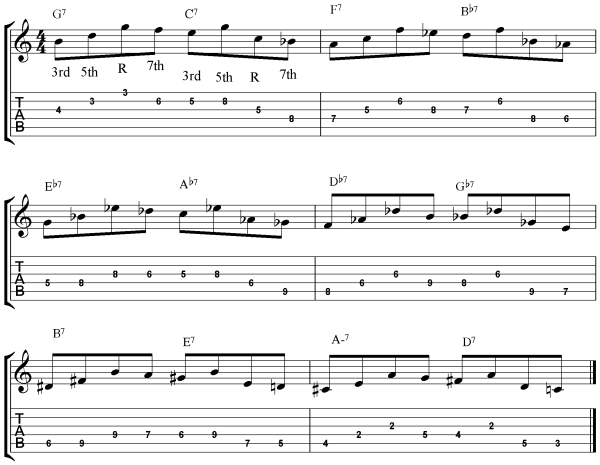
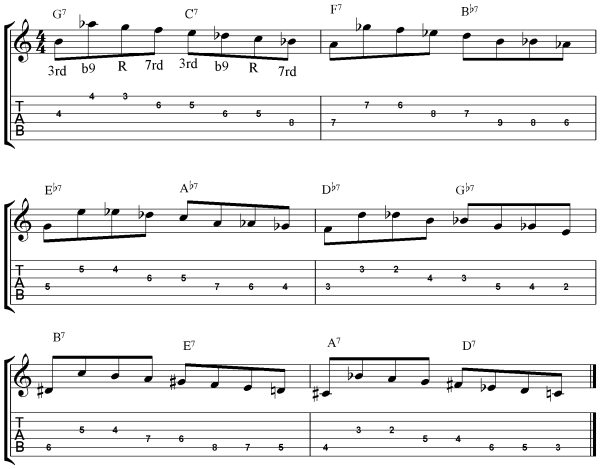

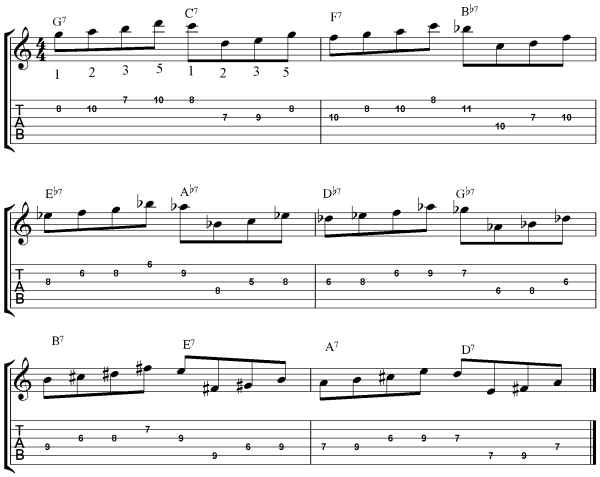
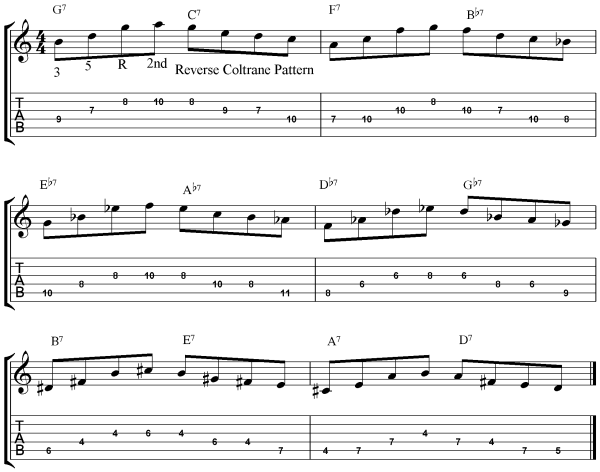
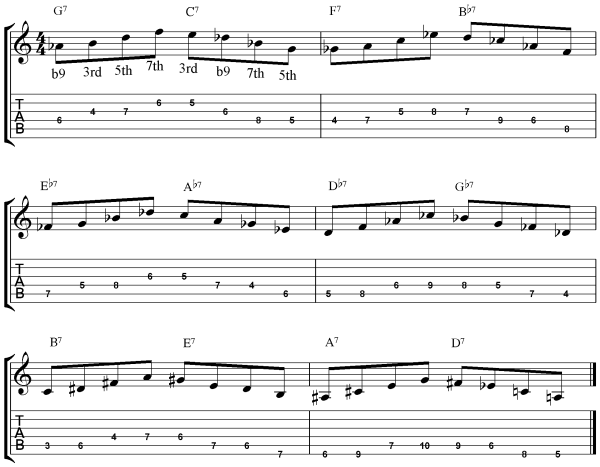



Hi Jamie,
Excellent studies.
I’m a subscriber to Barry Greene’s lessons…….Whew!…..
He doesn’t muck around….ha ha….No good for beginners in jazz.
Quite a stretch, keeping up, and I thought I knew my stuff.
I’m thinking of putting up a post on the Jazz Guitar Forum about
Barry’s work…it really is first rate.
But the main reason I contacted you is to enquire how to
print out your excellent lessons without getting “bleed over”
from one page to the next.
It seems that you are using a similar format as Matt Warnock,
who’s page I’ve encountered the same prob.
Any hints as to what to do…..other than….bleep…bleep…
bleep…ha ha
Best wishes….keep up the good work…..Milton
Gosh, I wish you had sound files to go with your lessons, maybe you have youtube with these lessons on, please let us know, thanks
Hi, I do have sound clips for most of the lessons but didn’t bother with this one because the rhythms are all the same and they are exercises. However, the first two examples are covered in Barry Greene’s lesson which you can view by following this link: http://www.youtube.com/watch?v=wVy09eO29sg
Nice lesson.,a lot of work ..—-
Thanks!
Thank you for the etudes!
https://m.facebook.com/pages/Manuel-Hobi-Quartet/449115761864107?id=449115761864107&refsrc=http%3A%2F%2Fwww.manuelhobi.ch%2Fquartet.html&viewtype=public&__user=100006945371893
Jamie,
I was going over these last night and had a question about the last measure in no. 3:
the A7 line uses an F as the 3rd note (between the A and the G) — should that be an E or the 5th of A7 ?
Just curious, the other lines in the etude don’t seem to follow that pattern.
Thanks for the warmups.
Thanks Jamie, tougher exercises than they look! I like the fact that you change up the fingering and direction so we don’t get too locked into one way of playing. Cheers!
Thanks for checking them out! Tough exercises but well worth it.
great material to do thanks
Well done Jamie. I love your website and the amount of knowledge you have about jazz.
Thanks for the kind words William!
Hi Jamie,
wich Barry Green’s lesson is this from ? The link you provide doesn’t work any more.
Is it a lesson from his website ?
Thanks in advance for your infos.
Rob
Hi Jamie, the link to the video doesn’t work. Is this video from Barry’s site ? In this case, what is the name of the lesson ? Thanks.
Hi Rod I think this is it: https://barrygreenevideolessons.vhx.tv/free-stuff/videos/2-technique-exercises
Hi Jamie Holroyd, thanks for the link. I must say this was a complete eye opener to me. It’s now incorporated in my daily routine. Do you know similar exercice with 2-5-1 through the 4th cyle ? Thanks in advance.